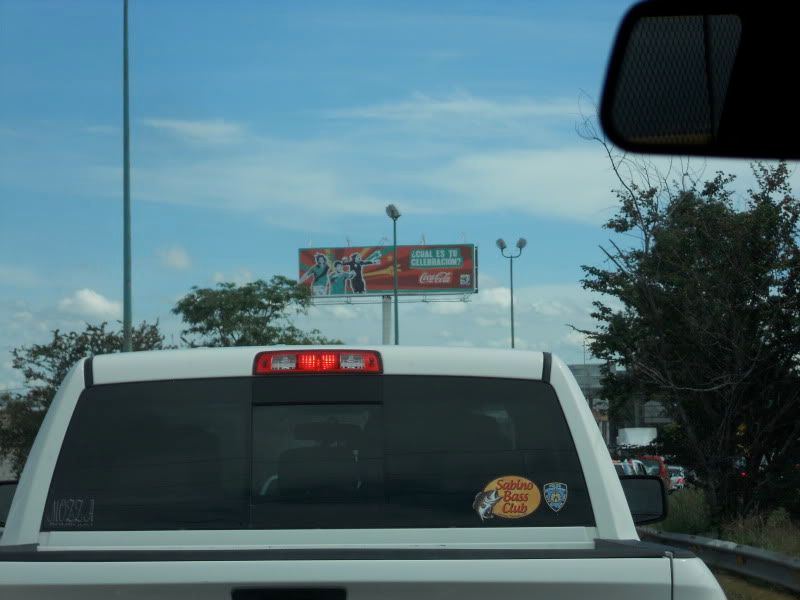The trip to the tianguis would have been far less significant to me if I had never visited Cuba. In Cuba, where everyone has their basic needs met, more or less, there is very little "stuff." Cubans themselves don't have the proliferation of toys, clothes, gadgets, etc, that Americans have, but Cuba so lacked in stuff that they didn't even have much to sell to the tourists. Apart from a few T-shirts, postcards, mugs, maracas, and rather racist looking statues of black women, there really wasn't much to buy in Cuba. That, contrasted with the tianguis, really made an impression on me.

Walmart on the way to the tianguis

Coca-Cola billboard on the way to the tianguis. It says "What is your celebration?"
About a mile before we arrived at the tianguis, our car came to a halt. Traffic was backed up the entire way from the highway exit to the market. Once inside, the aisles in between booths were equally stuffed with people. And, really, there wasn't much there I wanted to buy. They had nice furniture, but I can't take that home. They had some nice clothes as well, but do I need more clothes? They even had live puppies for sale! I would have loved to try the food, but I was on high "food poisoning" alert so I didn't dare. Most of the stuff was just junk.








I settled on a pair of malachite dangly earrings for myself and bracelets with colorful tumbled gems and peace signs for my stepkids. I also bought one T-shirt that looked traditionally Mexican, and my favorite purchase of all was a 6-inch skeleton dressed up in a fancy dress and a hat with feathers on it. THAT is a souvenir from Mexico. Since we don't celebrate El Dia de los Muertos (Day of the Dead, November 2) in our house, the skeleton will go on our Christmas tree instead.
Others in our group bought jewelry, clothes, home furnishings, and a purse. Nobody, that I saw, went for any of the religious paraphernalia up for grabs in the market. A number of booths were entirely dedicated to selling images and statues of Jesus and the Virgin Mary. (Later in the trip, my room mate won a 5"x7" Virgin Mary picture as a prize at a carnival.) Anything you've ever head about the influence of the Catholic church on Mexican culture is no exaggeration.
The insanity of the tianguis is that there are people in Mexico - a great many people in Mexico - who do not have enough food to eat throughout the year and, because they grow their food for their own consumption, have almost no money at all. Even those in Mexico who do have money can hardly purchase Mexican-grown organic food items because they simply aren't available. In the U.S. we drink Fair Trade, organic, shade grown, bird friendly Mexican coffee. The Mexicans drink Nescafe. The concept of local, sustainable food in Mexico is nearly non-existent, and even getting organic food produced via monoculture in a large operation somewhere in Mexico can be difficult. But if you're in the market for crap, Mexico has what you are looking for at the tianguis.
On the way to the tianguis, we passed a Wal-Mart. I also took picture of the Fanta billboard which claims that the soda changes color (tell me THAT chemical is good for you!) and several other signs for American multinational corporations. There's no shortage of fast food in Mexico. Mexicans still eat traditional Mexican food as well, and they have plenty of other healthy options in cosmopolitan Guadalajara - if they have the money - but, like in the U.S., every grocery store and convenience store is full of processed, packaged, branded crap.

Fanta billboard
Of course, there's nothing wrong with having opportunities to purchase gadgets, toys, clothes, or 3-foot tall Jesus on the Cross statues, but compared to healthy food, none of these items are essential in one's life. And in a country where so many people are hungry, these goods are merely a distraction. Furthermore, who is making these goods, and what are their lives like?
After making my way through the crowds, I sat down with my fellow travelers to wait for the bus. One member of our group, a talented photographer, told me he didn't spend much time in the market because he wanted to walk around and see the various "workshops" where the crafts were made. These were sweatshops, he told me. Many were contracted with U.S. businesses and the goods they made were sent directly to the U.S. I reflected on my purchases, now a little ashamed that they had likely been made in sweatshops only a stones throw away from the market. How many of the people in the cars lined up to come shopping gave any thought to the lives of the people who made the goods they were about to purchase? Thankfully, the jewelry I bought came from a man who was clearly making the jewelry on-site, and not in a sweatshop.
For Mexican peasants, coming to the city to work in a sweatshop or a factory is one way to make a living. However, the minimum wage in Mexico is low, and a campesino can make in the U.S. in an hour what he or she might make in Mexico in an entire day. For many, it's better to save the necessary $3000 to pay a coyote for help crossing the border and then live apart from family members while working 12-13 hours per day, six to seven days a week (with no overtime pay) in the fields in the U.S. than to live nearer to one's family in Mexico and to work for a fraction of the money.

Billboards and signs on the way home: Nextel, Walmart, and KFC

A McDonalds on the way home
No comments:
Post a Comment